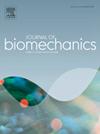AI-based human whole-body posture-prediction in continuous load reaching/leaving activities
IF 2.4
3区 医学
Q3 BIOPHYSICS
引用次数: 0
Abstract
Determining worker’s body posture during load handling activities is the first step toward assessing and managing occupational risk of musculoskeletal injuries. Traditional approaches for the measurement of body posture are impractical in real work settings due to the required laboratory setups and occlusion issues. This study aims to develop artificial neural networks (ANNs) to predict full-body 3D continuous posture during load-reaching and load-leaving phases of lifting and lowering activities thus complementing our previous posture prediction ANNs for the load-moving phase (i.e., the lifting activity between load-reaching and load-leaving phases). Using an existing whole-body motion dataset from twenty healthy young novice subjects during 204 load-reaching and load-leaving tasks, four ANNs were developed to estimate body continuous coordinates and segment/joint angles based on task- and subject-specific parameters as inputs. Results indicated that the developed ANNs achieved root-mean-square-errors of <3 cm and <10° for load-reaching and <4 cm and <15° for load-leaving tasks for the whole-body under random hold-out validation. The maximum posture prediction errors were observed at the left side of the body and the prediction errors were larger during the second half of the activities. Compared to prior static posture prediction models, our approach enabled continuous, phase-specific posture prediction thereby improving relevance for ergonomic and biomechanical applications. Although further investigations are required across diverse demographics (e.g., for female, elderly, experienced individuals), the present ANNs represent a step toward more accessible posture prediction tools in occupational settings, potentially reducing data collection demands for ergonomic assessments.
求助全文
约1分钟内获得全文
求助全文
来源期刊

Journal of biomechanics
生物-工程:生物医学
CiteScore
5.10
自引率
4.20%
发文量
345
审稿时长
1 months
期刊介绍:
The Journal of Biomechanics publishes reports of original and substantial findings using the principles of mechanics to explore biological problems. Analytical, as well as experimental papers may be submitted, and the journal accepts original articles, surveys and perspective articles (usually by Editorial invitation only), book reviews and letters to the Editor. The criteria for acceptance of manuscripts include excellence, novelty, significance, clarity, conciseness and interest to the readership.
Papers published in the journal may cover a wide range of topics in biomechanics, including, but not limited to:
-Fundamental Topics - Biomechanics of the musculoskeletal, cardiovascular, and respiratory systems, mechanics of hard and soft tissues, biofluid mechanics, mechanics of prostheses and implant-tissue interfaces, mechanics of cells.
-Cardiovascular and Respiratory Biomechanics - Mechanics of blood-flow, air-flow, mechanics of the soft tissues, flow-tissue or flow-prosthesis interactions.
-Cell Biomechanics - Biomechanic analyses of cells, membranes and sub-cellular structures; the relationship of the mechanical environment to cell and tissue response.
-Dental Biomechanics - Design and analysis of dental tissues and prostheses, mechanics of chewing.
-Functional Tissue Engineering - The role of biomechanical factors in engineered tissue replacements and regenerative medicine.
-Injury Biomechanics - Mechanics of impact and trauma, dynamics of man-machine interaction.
-Molecular Biomechanics - Mechanical analyses of biomolecules.
-Orthopedic Biomechanics - Mechanics of fracture and fracture fixation, mechanics of implants and implant fixation, mechanics of bones and joints, wear of natural and artificial joints.
-Rehabilitation Biomechanics - Analyses of gait, mechanics of prosthetics and orthotics.
-Sports Biomechanics - Mechanical analyses of sports performance.
 求助内容:
求助内容: 应助结果提醒方式:
应助结果提醒方式:


